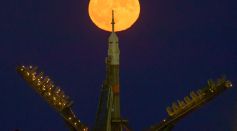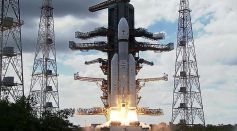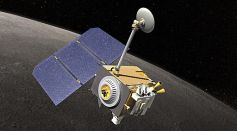Tags: Moon
India’s Chandrayaan-3, Russia’s Luna 25 Set To Land on Moon Next Week for Their Lunar Missions

Russia's Luna-25 Mission Shares First Images From Space, Revealing Earth and Moon in Cosmic Perspective

Russia Resumes Lunar Ambitions with Launch of Luna-25 Mission, Entering Moon Race Alongside India

India's Chandrayaan-3 Spacecraft Reveals First Moon Images Ahead of Anticipated Lunar Landing Attempt
Powerful Solar Outburst Hit Earth, Moon, Mars for the First Time [Study]
Fibonacci's Ancient Math Unveils New Approach to Lunar Navigation for Future Moon Missions

Triple Planetary Solar Storm: Unprecedented Eruption Simultaneously Hits Earth, Moon, Mars
NASA Distributes $150 Million to 11 US Organizations Supporting Human Explorations on the Moon

Apollo 11's 54th Lunar Landing Anniversary: Buzz Aldrin Shares How He Celebrates International Moon Day

Mars Express Orbiter Captures Earth, Moon From the Martian Perspective, Showing It as a Fuzzy Blob in the Center

India’s Chandrayaan-3 Mission Successfully Starts Journey to the Moon’s South Pole

'Man in the Moon' Age? New Analysis Reveals That These Craters Could Be 200 Million Years Older Than Thought

Radioactive Rock Discovered Underneath the Moon's Surface, In Its Region Known as the Compton-Belkovich 'Anomaly'

Granite Discovered Beneath an Ancient Lunar Volcano, Supporting Evidence of Volcanic Activity on Moon's Far Side
Indian Space Research Organization (ISRO) Set To Launch Lunar Lander Chandrayaan-3 Next Week

Lunar Reconnaissance Orbiter Which Has Been Providing Views of Moon for 14 Years Is Reaching the End of Its Lifetime
Jeremy Hansen of Artemis 2 Is Optimistic Canadian Astronaut Will Walk on the Moon, Go to Mars
Robotics Company Designs Power Grid on the Moon Using Lunar Resources To Generate Solar Energy

Lunar Weather Explained: NASA Scientist Describes How the Conditions of the Sun Affects the Moon

Celestial Event Alert: Moon and Mercury Conjunction Near the Glowing Eye of Taurus Constellation
Most Popular

Largest Known Volcanic Aquifer Discovered Beneath Oregon's Cascades

New 'Supergiant' Sea Bug Found in South China Sea, Named After Darth Vader

Mediterranean Sea Was Refilled by a Catastrophic Flood Millions of Years Ago

Mysterious Cosmic Waves That Sound Like Birds Detected in Unexpected Space Region





